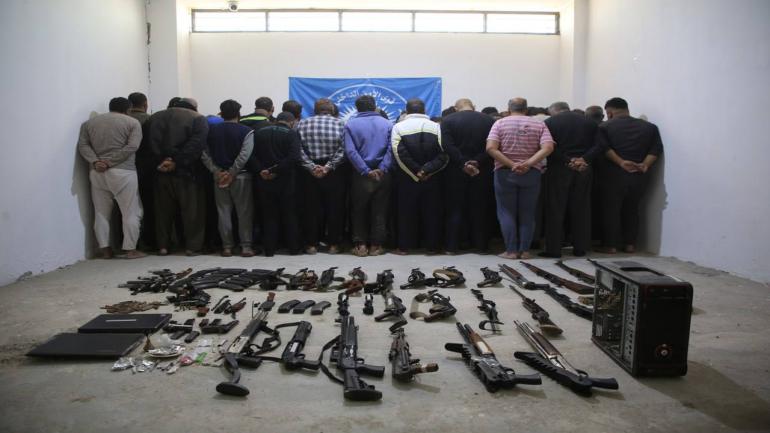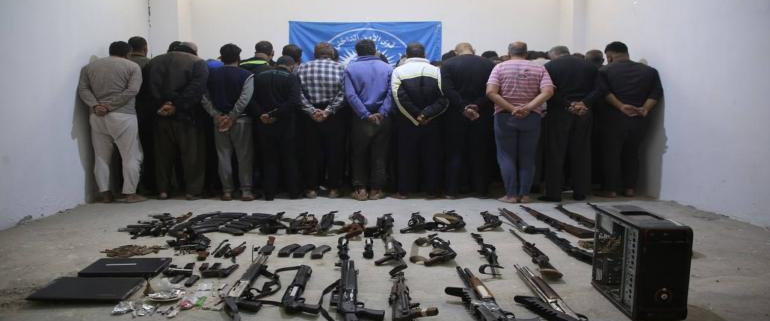March Sleeper Cell Report – Moscow attack puts international spotlight on ISIS’ enduring threat

Key points
- 27 sleeper cell attacks in March, just one up from February
- 10 military personnel killed, 13 military personnel injured, 1 civilian killed in ISIS attacks
- 6 ISIS members killed and 31 arrested in 7 SDF/Asayish raids – a decrease in the number of arrests and raids compared with February
- Russia repatriated 32 children from NES, Spain repatriated 2 women and 2 children
- Iraq repatriated 620 individuals from al-Hol camp
In-depth
ISIS again took global headlines this month, following an attack in Crocus City Hall in Moscow, in which ISIS killed 144 people and wounding 551. 95 more were missing after a fire started in the building. In NES, RIC recorded 27 sleeper cell attacks in March, just topping the 26 observed in February. The overwhelming majority of these attacks happened in the Deir ez-Zor canton, with only 2 occurring elsewhere. ISIS’ March attacks killed 10 military personnel and injured 13, and killed 1 civilian. The number of raids conducted by the SDF and Asayish fell to 7 – just over half that of February’s 13. During these raids, 31 ISIS members were arrested and 6 killed.
At the start of the month, the SDF and International Coalition conducted a raid in the area of al-Hariji in Deir ez-Zor, arresting 10 ISIS members reportedly tasked with assassinations. Some days later, the Asayish conducted a large-scale security operation covering the areas of Shaddadi, Markadah and southern Heseke countryside. In a statement, the Asayish claimed they arrested 47 people, including 13 ISIS members as well as “Turkish occupation mercenaries” and “members of sabotage groups”.

Amongst those arrested by the Asayish on March 4th were 13 ISIS members.
ISIS continued to take advantage of the ongoing instability in Deir ez-Zor. On March 7th, an SDF fighter was injured after two members of ISIS attacked a military headquarters with a hand grenade in al-Basirah. On March 10th, a member of the Asayish was killed and three others were injured in an explosion targeting their vehicle in Abo Hardoub. Five days later, another ISIS attack in al-Basirah saw an SDF fighter injured. Beyond attacks targeting military and security forces, ISIS attacks on Deir ez-Zor’s civilian population continued in March. ISIS has put particular pressure on those working in the oil sector, conducting several attacks on oil trucks as well as a grenade attack on the house of a local oil investor on March 19th, in al-Jarzy. Furthermore, on March 4th and 7th, in Abriha and Abo Hardoub towns, sleeper cells targeted two civilian houses, after their inhabitants had refused to pay “zakat” (taxes). These attacks left no casualties.
In Raqqa, on March 24th, the SDF carried out a raid in the city centre, targeting an ISIS official, “Sameer Khudir al-Shihan, an Iraqi national responsible for funding ISIS cells within the city.” After refusing calls to surrender, the SDF killed him. Three days after this raid, an ISIS sleeper cell attack on an administrative office of the Raqqa Military Council in Raqqa’s Dariyah neighbourhood led to clashes between the security forces and the ISIS militants. Two SDF fighters were killed and a civilian was injured. The SDF stated: “Our forces pursued the attackers. One suspected terrorist was injured and apprehended. The search for the remaining members of the terrorist group is ongoing.”
March sleeper cell activity in al-Hol camp again attested to the growing risk posed by the camp, particularly in relation to its foreign national inhabitants. A UN Syria Commission of Inquiry member said this month that the situation of al-Hol is “creating a problem which will come back to haunt us, in terms of being a breeding ground for terrorism.” On March 18th, an Egyptian woman – the wife of a ISIS commander – and her children were reported missing from the camp. It is believed that when they visited the Syrian Red Crescent Hospital and the Red Cross medical clinic they got smuggled out of the camp. 6 days later, the SDF announced the arrest of two “cubs of the caliphate” – from Indonesia and Turkmenistan respectively – as they attempted to flee al-Hol camp with a smuggler.
In this month, both Russia and Spain repatriated ISIS-linked nationals from NES. Russia took home another 32 children, while Spain took 2 women and 2 children. The total number of Russians repatriated now stands at 513 – the 2nd highest globally – as per RIC data.
Iraq also repatriated 150 ISIS-linked families (620 individuals) from al-Hol camp. RIC records a total of 3,331 third-country foreigners and 16,318 Iraqi citizens as having been repatriated, yet 6,855 foreigners and 22,091 Iraqis remain in the camp. Combined with the 17,453 Syrian nationals living there, the camp’s population is 46,399.

Amidst rising concerns of a potential ISIS resurgence following the latter’s attack in Moscow on March 22nd, Wall Street Journal also drew attention to the issue of the global security threat posed by al-Hol camp, quoting Dana Stroul, a former senior Pentagon official for the Middle East, as saying “absolutely al-Hol is a ticking time bomb.” Following ISIS’ Moscow attack, the SDC stated: “The assault once again underscores the capacity of terrorists to conduct attacks within the unstable international situation, and we caution against the efforts of these terrorist groups in fuelling conflicts.” The DAANES also issued a statement condemning the attack in Moscow and stressed that “the path of combating terrorism is a necessary and important measure, and it is work that requires full and complete cooperation between all forces keen to fight to end it.”
March 23rd marked 5 years since the final defeat of ISIS’ so-called caliphate in the town of Baghouz in Deir ez-Zor. The SDF held a ceremony to mark the anniversary, which International Coalition forces, Deir ez-Zor’s SDF military institutions and the region’s tribal sheikhs and notables and some residents attended.
Military ceremony to mark 5 years since the SDF’s final victory over ISIS in Baghouz.

